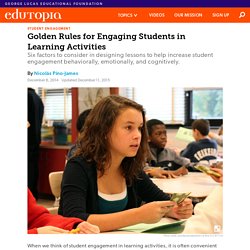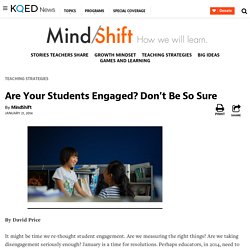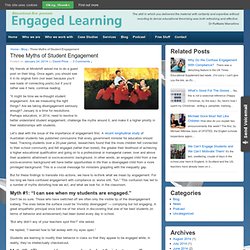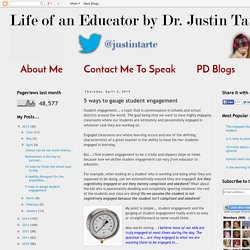

Golden Rules for Engaging Students in Learning Activities. 1.

Make It Meaningful In aiming for full engagement, it is essential that students perceive activities as being meaningful. Research has shown that if students do not consider a learning activity worthy of their time and effort, they might not engage in a satisfactory way, or may even disengage entirely in response (Fredricks, Blumenfeld, & Paris, 2004). To ensure that activities are personally meaningful, we can, for example, connect them with students' previous knowledge and experiences, highlighting the value of an assigned activity in personally relevant ways. Also, adult or expert modeling can help to demonstrate why an individual activity is worth pursuing, and when and how it is used in real life. 2.
The notion of competence may be understood as a student's ongoing personal evaluation of whether he or she can succeed in a learning activity or challenge. 3. We may understand autonomy support as nurturing the students' sense of control over their behaviors and goals. 4. 5. 6. Are Your Students Engaged? Don’t Be So Sure. By David Price It might be time we re-thought student engagement.

Are we measuring the right things? Are we taking disengagement seriously enough? January is a time for resolutions. Perhaps educators, in 2014, need to resolve to better understand student engagement, challenge the myths around it, and make it a higher priority in their relationships with students. Let’s deal with the issue of the importance of engagement first. But for these findings to translate into actions, we have to re-think what we mean by engagement.
Myth #1: “I can see when my students are engaged.” Don’t be so sure. “But why didn’t any of your teachers spot this?” He replied, “I learned how to fall asleep with my eyes open.” Students are learning to modify their behavior in class so that they appear to be engaged while, in reality, they’ve intellectually checked-out. Myth #2 : “They must be engaged — look at their test scores!” 10 Ways to Inspire a Love of Learning. In 2008, Jessica Seinfeld released a cookbook for parents called “Deceptively Delicious.”

At the time, I was a newly-minted mother of a solid-food eating child. Seinfeld’s book was all the rage among the other new mothers in my mama tribe. The recipes were “stealthily packed with veggies hidden in them so kids don’t even know!” Yeah, I ordered a copy faster than a new parent can say “Amazon Prime.” But one day, as I watched our young daughter polish off yet another bag of organic Just Peas, it occurred to me – the girl loved vegetables. Seven years later, we have a second grader who has never met a fruit or vegetable she won’t taste, picks Saag Paneer at Ambar to celebrate every birthday and packs salads for school lunch. Could a similar, intentional approach to learning have the same results?
Guided by those questions, “The intentional weekend” was born. Here are 10 recommendations for being intentional about inspiring lifelong learners, based on experiences from our family. Engaged Learning. My friends at Mindshift asked me to do a guest post on their blog.

Once again, you should see it in its original form (not least because you’ll see loads of connecting posts) but if you’d rather see it here, continue reading: “It might be time we re-thought student engagement. Are we measuring the right things? Are we taking disengagement seriously enough? January is a time for resolutions. Let’s deal with the issue of the importance of engagement first. But for these findings to translate into actions, we have to re-think what we mean by engagement. 5 ways to gauge student engagement. Student engagement... a topic that is commonplace in schools and school districts around the world.

The goal being that we want to have highly engaging classrooms where our students are intimately and passionately engaged in whatever task they are working on. Engaged classrooms are where learning occurs and one of the defining characteristics of a great teacher is the ability to have his/her students engaged in learning. But...I find student engagement to be a tricky and slippery slope at times because how we define student engagement can vary from educator to educator.
For example, when looking at a student who is working and doing what they are supposed to be doing, can we automatically assume they are engaged? Are they cognitively engaged or are they merely compliant and obedient? My point is simple... student engagement and the gauging of student engagement really aren't as easy or straightforward as some would think. Also worth noting... 1).